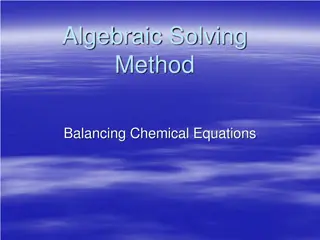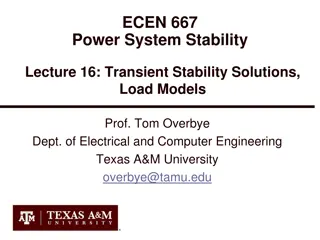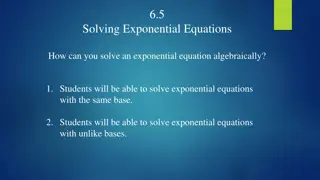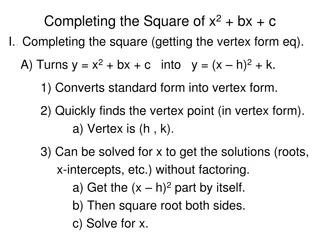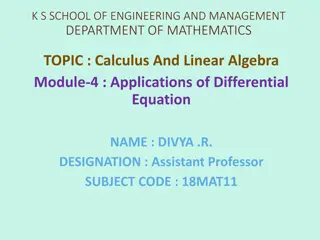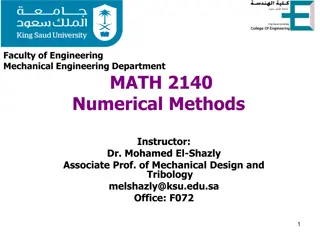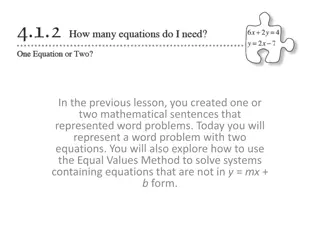Understanding Newton's Method for Solving Equations
Newton's Method, also known as the Newton-Raphson method, is a powerful tool for approximating roots of equations. By iteratively improving initial guesses using tangent lines, this method converges towards accurate solutions. This method plays a crucial role in modern calculators and computers for solving complex equations efficiently.
Download Presentation

Please find below an Image/Link to download the presentation.
The content on the website is provided AS IS for your information and personal use only. It may not be sold, licensed, or shared on other websites without obtaining consent from the author. Download presentation by click this link. If you encounter any issues during the download, it is possible that the publisher has removed the file from their server.
E N D
Presentation Transcript
4.8 Newtons Method: Suppose that a car dealer offers to sell you a car for $18,000 or for payments of $375 per month for five years. You would like to know what monthly interest rate the dealer is, in effect, charging you. To find the answer, you have to solve the equation 48x(1 + x)60 (1 + x)60 + 1 = 0 We can find an approximate solution to the equation above by plotting the left side of the equation. Using a graphing device, and after experimenting with viewing rectangles, we produce the graph in the figure below. Using the ZERO feature on our graphing calculator, the correct rate to nine decimal places, is 0.007628603. We see that in addition to the solution x= 0, which doesn t interest us, there is a solution between 0.006 and 0.008.
How do these devices solve equations? They use a variety of methods, but most of them make some use of Newton s method, also called the Newton-Raphson method. We will explain how this method works, partly to show what happens inside a calculator or computer, and partly as an application of the idea of linear approximation. Newton s Method: The geometry behind Newton s method is shown in the figure, where the root that we are trying to find is labeled ___. r x1 We start with a first approximation ____, which is obtained by guessing, or from a rough sketch of the graph of f, or from a computer-generated graph of f. Consider the tangent line L to the curve y = f (x) at the point (x1, f (x1)) and look at the x-intercept of L, labeled______ . x2
The idea behind Newtons method is that the tangent line is close to the curve and so its x-intercept, x2, is close to the x-intercept of the curve (namely, the root r that we are seeking). Because the tangent is a line, we can easily find its x-intercept To find a formula for x2 in terms of x1 we use the fact that the slope of L is f (x1), so its equation is y f (x1) = f (x1)(x x1) Since the x-intercept of L is x2, we know that the point (x2, 0)is on the line, and so 0 f (x1) = f (x1)(x2 x1) If f (x1) 0, we can solve this equation for x2: ?2= ?1 ? ?1 ? ?1 We use x2 as a second approximation to r.
Next we repeat this procedure with x1 replaced by the second approximation x2, using the tangent line at ( ___, _____ ). x2 f(x2) ?3= ?2 ? ?2 This gives a third approximation: ? ?2 ( ) ( ) x2, f x2 ( ) ( ) If we keep repeating this process, we obtain a sequence of approximations x1, x2, x3, x4, . . . as shown in the figure. x3, f x3 x3 x4
In general, if the nth approximation is xn and f(xn) 0, then the next approximation is given by If the numbers xn become closer and closer to r as n becomes large, then we say that the sequence convergesto r and we write
EX #1: Starting with x1 = 2, find the third approximation x3 to the root of the equation x3 2x 5 = 0. f x ( )= x3-2x-5 xn+1= xn- f ' xn n=1 With x1+1= x2= x1- f ' x1 ( ) 1st approx. ( ) f ' x ( )= 3x2-2 = 2--1 10= 2.1= x2 f xn ( ) f x1 ( ) f 2 ( ) f ' 2 ( ) 2 ( ) 3-2 2 ( )-5 3 2 ( ) = 2- = 2- 2-2 2nd approx. With n= 2 ( ) ( )= 2.1- f 2.1 ( f ' 2.1 ( ) ) ( ) ( 2-2 )-5 3-2 2.1 ( f x2 f ' x2 2.1 = 2.1-0.061 x2+1= x3= x2- = 2.1- ) 11.23 3 2.1 2.094568121 x3 3rd approx.
x3 x4 x5
EX #2: Use Newton s method to find 62 correct to eight decimal places. ??. x6= 2 x6-2= 0 f x ( )= x6-2 We need to create a function where x = ( ) f ' xn n=1 With f xn ( ) xn+1= xn- f ' x ( )= 6x5 x2 x3 x1=1 f 1 ( ) f ' 1 ( ) 1 ( ) 6-2 6 1 ( ) 1 6 1 6 x1+1= x2=1- = + = = =1- 1 1 1.6 x4 5 x5 x6 x7
EX #3: Find, correct to six decimal places, the root of the equation cos? = ?. cos x ( )- x = 0 f ' x ( )= -sin x ( )-1 f x ( )=cos x ( )- x p 2 x1=0.75 1.57 x2 x3 x4 x5
EX #4: Use Newton s method to approximate, correct to six decimal places, the indicated root of ?4 2?3+ 5?2 6 = 0 in the interval [1, 2]. f x ( )= x4-2x3+5x2-6 f 1 ( )=1-2+5-6= -2 f 2 ( )=16-16+20-6=14 By the Intermediate Value Theorem, there is a number c in (1, 2) such that f(c) = 0, so x1= 1 f ' x ( )= 4x3-6x2+10x x2= x3 x4 x5






